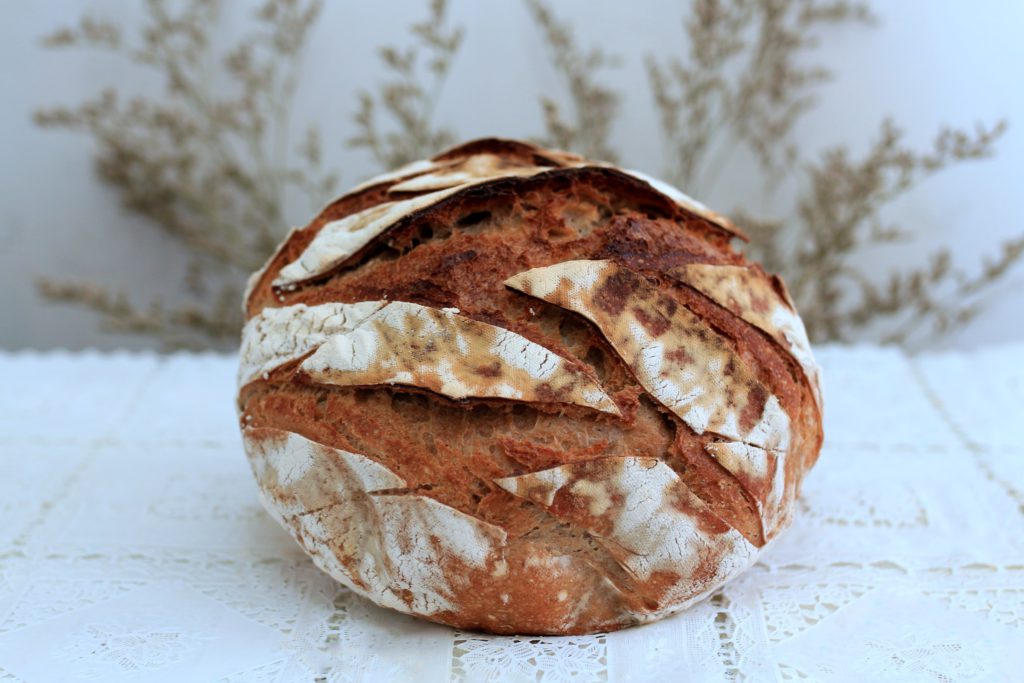Do you speak Sourdough?

Hello again, my Sourdough Sodality! I’m back with more Bread Ed, this time to help you get a starter on your starter.
In the previous article, we learned what sourdough is and discussed the pros and pros of making the switch. Now that we’ve been through the what and why, let’s talk about the how.
Have you ever asked questions like; why does the starter look, feel and, smell a certain way? Is it supposed to be this way or has something gone wrong? Should I compare mine to other starters?
Here’s what you need to know.
Your starter is your very own living creation. Feeds on flour and water. Breathes and expels out CO2. Grows every day and speaks to you. Tells you what it needs and how it feels. So the real questions should be; do you speak sourdough? Are you fluent like Sujit Sumitran? Or, are you new to this cultured lingo?
3 signs of communication

1. Bubbles and web
As the dough ferments, the yeast develops. It needs food to grow like any living organism. So it feeds on the sugar content in the flour (starch) and expels CO2 in turn. However, your yeast baby is currently trapped among elastic gluten strands of the dough. Hence the air expelled cannot escape and gets trapped in the dough. The dough is stretched with each expulsion and air is encased in these stretched bits of elastic dough creating bubbles on the surface.
As for the action below the surface, the CO2 eventually escapes leaving multiple small creators within the layers and on the sides. This can also be recognized as what appears to be a web-like structure within the dough, underneath the top layer and on the sides.
2. Rise and fall
So when the starter is well-fed, it expels CO2 which aerates the dough. This results in increased volume and therefore a visible rise at first. Eventually, it will run out of food and so, it stops breathing out. At this point, the culture is resting and waiting for the next feed. During this time some of the gas trapped in bubbles slowly escapes the dough. This causes the dough to return to its volume before the rise. Hence, the dough looks deflated or fallen.
3. Smell
By now you understand that your starter is alive and grows every day. But did you know the yeast baby has a friend in there to grow up with?
As the culture develops, a certain lactic acid bacterium also begins to grow. This bacterium is responsible for the rich tangy flavor of your beloved sourdough bread. As the job of this bacteria is to put the “sour” in sourdough, it also puts the sour-smelling characteristic in your starter. The sours smell can sometimes be perceived as unpleasant. This is because people are often conditioned to believe the sour smell to be a sign of food gone off. Although it can be true to some extent, it is not the case for sourdough. Food that has been unintentionally fermented might contain other unwanted bacteria.
However, the lactic acid in sourdough is wanted, appreciated and loved. Even if it comes off a little too strong at first, it learns to mellow down and the final baked product hits the sweet spot.

Talking back
Understanding the language is important. But so is responding. Now that you know what these signs are communicating, how will you let your starter know that you’re here to take care of things?
1. Temperature
Your yeast baby, after all, is a baby. It is fragile and needs attention. Neither will it grow in frigid conditions, nor can it survive extreme heat. A specific window of 24-30 degree Celsius is where the yeast and the bacterium thrive. This is because too cold of an environment will send the starter into hibernation mode. This just means that the microbes are not able to develop. People sometimes refrigerate or freeze their starters to pause or preserve them as well. Therefore these can be revived.
But the same cannot be done if the yeast dies. Extreme heat (above 35-37 degrees Celsius) can kill any living microbe or bacteria. This happens when baking the bread, as it should due to high baking temperature. But you wouldn’t want to kill the yeast before it is done growing, would you?
2. Humidity
wild yeast is naturally found in flour as well as in the environment. So why are bread, dough and so many other things not fermenting on their own every day? This is because yeast requires water to be activated. Water is added to the four to aid the activation.
However, the yeast found in the air in your surroundings also needs water to thrive. If the air lacks moisture, the yeast is much less likely to develop or even to be found. Humidity also helps in maintaining the water content of your starter. The starter requires air to breathe as well. Since the lid is required to be loose fitting, allowing oxygen to come in and CO2 to flow out, a small amount of water can also evaporate in a hot and dry environment. his results in the drying of the dough and thus inhibits the growth of the culture.
3. Food
Needless to say, fuel is essential for the growth of any living organism. your starter mainly feeds on the sugars found in the flour in the form of starch. Once it has consumed all the sugar available, it demands to be fed again.
As mentioned repeatedly, the starter is your baby and not a camel. So it can’t be fed all of the flour in one go. It needs small meals at regular intervals. Personal judgment will be required at times. If the yeast is not alive and thriving yet, it will not be able to consume any sugar. If it appears to be growing and breathing, it will most probably be eating as well.

Patience
Learning the language and healthy communication is key. I hope I have been able to help you in building mutual understanding. But this article simply gives you some guidance and lays out the facts. At the end of the day, patience is a must.
It takes time to understand the individuality of your little one. Some starters are hungrier, some feel too cold. Even with the same recipe, another starter might behave differently and that is alright.
Do not compare your flour child to Sharma Ji’s Sour-son. They’re doing the best they can. All they need is cooperation and support.


Loved this one too. You’re a natural writer girl! ❤️
Informative and witty and loved the sharmaji’s son bit!
thanks a tonn @sharyu.vaidya.2913! love your enthusiasm to read and learn!
Very informative and well written 👌👌
Thank you! ❤️
Very informative 🥰
Love it. Very informative thank you
so so so informative 🙂
Very useful information!! Good to revise the facts on and off , even though I am baking sourdough breads since last 2 years
I think this is one of the most significant info for me. And i’m glad reading your article. But want to remark on some general things, The website style is perfect, the articles is really nice : D. Good job, cheers